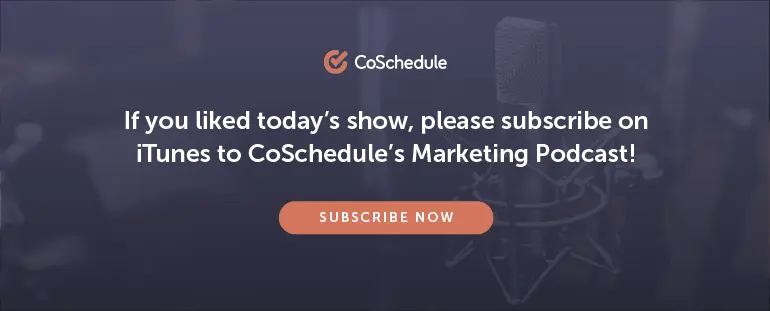How Marketing Consultants Can Successfully Onboard Clients Onto Software Platforms (Even When They’re Used to Using Different Tools) With Andrea Moxham from Horseshoe & Co. [AMP 170]
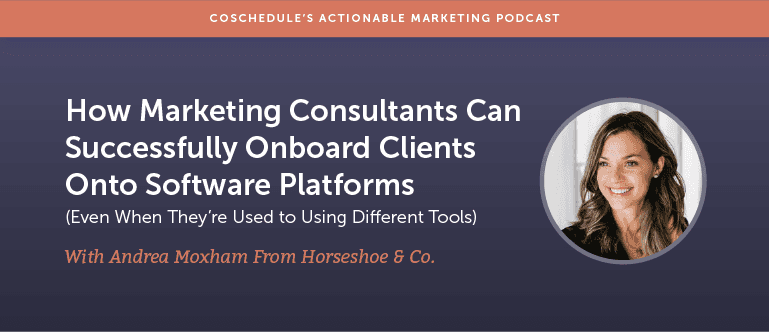 Excuses, excuses. Too many tools? Too complicated? Too stressful? It takes time and help to learn how to use new software effectively, especially if you don’t use it regularly. How can marketers successfully onboard new clients and convince them to switch to new software tools and platforms?
Today’s guest is Andrea Moxham, co-founder and co-owner of Horseshoe & Co. The HubSpot consultancy and partner program member helps businesses understand how to use the comprehensive marketing automation tool to create a cohesive inbound marketing strategy.
Some of the highlights of the show include:
Excuses, excuses. Too many tools? Too complicated? Too stressful? It takes time and help to learn how to use new software effectively, especially if you don’t use it regularly. How can marketers successfully onboard new clients and convince them to switch to new software tools and platforms?
Today’s guest is Andrea Moxham, co-founder and co-owner of Horseshoe & Co. The HubSpot consultancy and partner program member helps businesses understand how to use the comprehensive marketing automation tool to create a cohesive inbound marketing strategy.
Some of the highlights of the show include:
- Common Challenges: Clients struggle to seamlessly transition to HubSpot and how to use its workflow feature
- Getting Started: Audit, segment, strategize, scale, and streamline sales and marketing processes
- Resistance or Skepticism? HubSpot ranks highly and doesn’t need buy-in from most decision makers
- Horseshoe & Co.’s Onboarding Process:
- Focus solely on HubSpot
- Focus on customer service, sales, marketing, and other initiatives
- Wish List: What do customers want to get out of HubSpot?
- Key to Success: Establish effective communication and expectations early on
- “We help businesses that are using HubSpot—the marketing automation tool—to kind of get the most bang for their buck.”
- “Becoming aware of the company at the same time in the same way that a new prospect would really helps us identify those bottlenecks and what we can do to help close them.”
- “There's always different ways that you can be using the existing tool.”
- “Establishing what effective communication means early on with your client...is really helpful.”
How Marketing Consultants Can Successfully Onboard Clients Onto Software Platforms (Even When They’re Used to Using Different Tools) With Andrea Moxham from Horseshoe & Co.
Click To TweetTranscript:
You're listening to the Actionable Marketing Podcast, powered by CoSchedule. The only way to organize your marketing in one place, helping marketers stay focused, deliver projects on time, and keep their entire marketing team happy. Ben: Hi everyone and welcome to another episode of the Actionable Marketing Podcast. I'm your host Ben Sailer and this week we have Andrea Moxham on the show, who is the co-owner (along with her husband) of a HubSpot Consultancy called Horseshoe + Co. She has tons of experiences successfully bringing on new clients and getting them successfully on boarded. If you are a consultant or working at an agency on a role that involves client onboarding and getting customers set up on to new software tools and platforms, I'm sure you'll come away from this show with a tip or two you can use. Now, here's the episode. How's it going Andrea? Andrea: Good. How are you Ben? Ben: I'm fantastic. Are you keeping warmed up there in Ontario? Andrea: As best as I can. I've got my fleece on, but it's like every winter that rolls around, I'm still shocked at how cold it is and how much snow we get. It's like this every winter, so I don't know why I'm not better prepared. Ben: I feel the same way. As some of our listeners might know, CoSchedule is based out of North Dakota and I feel like it's a very similar story for all of us. Down here, no matter how many years I go through this, I just feel like it's a shock. Andrea: Right, and it doesn't make it any worse, that other western parts of the US are just like, "Oh, it's so cold here this winter," when it's many, many degrees warmer than it is here. Ben: Yeah, for sure. It changes your whole perspective on what you are willing to accept someone saying as “cold” in any way. Andrea: Yes. Our standards are a lot lower or higher, I don't know which would it be. Ben: Definitely it’s skewed. Just introduce yourself to our audience and explain what you do with your agency, Horseshoe + Co. Andrea: Sure. My name is Andrea Moxham and I am the co-founder of Horseshoe + Co. Myself and my husband own the company. We don't really typically call ourselves an agency. We have a small team so it's not just him and I. We've got a couple different employees and contractors, but we don't really refer to ourselves as an agency because we operate as a different model. We operate as more of a consulting type model and we help businesses that are using HubSpot (the marketing automation tool), to get the most bang for their buck and really make sure that they're driving a cohesive strategy using the tool and the way that it fits into their bigger inbound marketing strategies. That's where we focus is on HubSpot.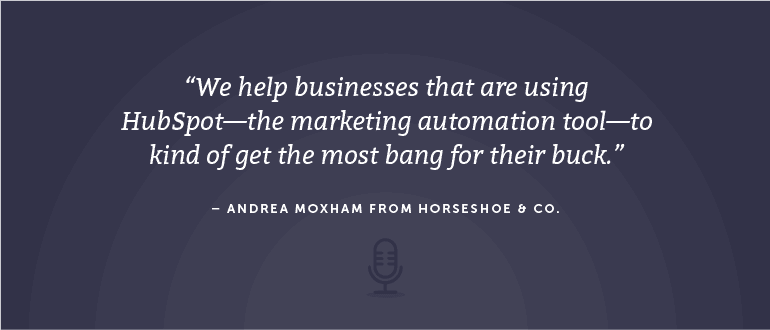 Ben: Would you say that the majority of your clients are clients who are already using HubSpot? They are coming to your for that expertise? Or do you have to ever spend much time convincing clients that you feel that is the best platform for them to use?
Andrea: The majority of our clients are already on HubSpot. We are part of the HubSpot partner program, so a big portion of that is helping us to get more clients on board. That isn't really our focus. It's really on the companies that are using HubSpot, struggling to get it to work for them, whether they are migrating from another tool or just don't have the resources to be using it everyday. We find that there's a huge chunk of companies in that second bucket that are on HubSpot, kind of poking around here and there, but not really diligently using it everyday. That's where our focus is.
Ben: What are some of the biggest challenges that you typically see? Or maybe just some common things that you typically find with clients who are struggling?
Andrea: I think I touched on this a second ago that a lot of companies will come from another either one tool or a set of tools. Because HubSpot is pretty comprehensive, it has the ability to help you scale back the number of tools that you are using but in doing so, you are probably leaving some sales team, internal staff left wondering, "Oh, I've been so used to using Salesforce," for example. A part of our relationship with our clients is not only helping them getting setup on HubSpot and get it working in a way that they make it a seamless transition but also training.
Doing screen shares, recording videos and things like that to help make that transition a little bit easier is probably the biggest friction point and probably the biggest source of leads (to be honest) that we get. It's just saying, "Hey, can you help us? We can't really figure out how to transition to HubSpot."
The second would probably be figuring out how to use workflows. This is a generic blanket statement, but there's a tool in HubSpot that allows you to set up workflows, but the capabilities of this tool are endless. You can use it for internal modifications. You can use it for drip campaigns. Because the nature of the tool is so broad and there's so much you can do with it, I think it gets a little bit complicated. You know you can get carried away and you set up a hundred different workflows and they are all conflicting and you've got people enrolled in two at once. Figuring out the workflow tool is another source of stress for a lot of companies using HubSpot.
Ben: Got it. Say if you have a client who is looking for help with workflows or with any aspect of just getting their heads how to use HubSpot effectively. Do you have any sort of framework for how you start approaching problems? Especially if they have like, "Here's a laundry list of things we need help with." How do you start getting them on the right track?
Andrea: Typically every project that starts with an audit. Like I mentioned, because the businesses are already using HubSpot, they often have a lot of hands in there. They have a lot going on, so it's best that we segment every bucket of HubSpot tools and audit what's going on. Find things that are conflicting and just start to make sense of this web of intricate stuff that is going on on HubSpot. Then help clean it up, but also strategize. Not just fixing things so that they are working a little bit better, but actually talking about best practices and the best way for that particular company to use this specific tool.
For example, if a company had 200 different workflows, taking a look at where we can consolidate and what the goal of these workflows are so that we can hopefully streamline, clean those up. But it also often comes down to improving their sales process is the biggest one. The companies are using workflows to automate some of their sales processes so we get involved with that as well. Not just fixing things, but getting into the weeds of sales process and some internal workflows to find out what we can do in HubSpot to help support those different tasks and initiatives.
Ben: Got it. Something else I'm curious about. When you are bringing on a new client, if it is a client that is coming to HubSpot from another tool, I would imagine that you probably have multiple stakeholders or people that you are working with within that organization that you all have to get onboard or bought into using HubSpot in order for it to be successful. Do you ever run into instances where there may be a resistance or skepticism to using that platform?
Andrea: Interesting question. Oddly enough (and I feel like this is kind of bizarre), it never really seems to be a problem and here's why. For at least a lot of the companies that we work with, they've got a marketing department, they've got a sales department, then they've got the higher level executive team that is in charge of making decisions. The executive team is more or less sold on using HubSpot. The value speaks for itself.
They are constantly introducing new tools. They rank so well, the company organically that if you are searching for any sales or marketing tip or help, HubSpot is going to rank highly. That really helps them establish authority in the marketing world. I feel like those executives, the people that are ultimately making the decision to buy HubSpot, they don't need any buy in. Where it gets a little bit tricky is they now sign up for HubSpot and it's the sales and marketing staff that are using these tools day in, day out that need a little bit of hand holding in terms of making that transition a little bit more seamless.
It's funny. We've got blogs and resources on our website on how to get buy-in for not just HubSpot but inbound marketing in general. Sometimes companies with (for lack of a better term) older executive team sometimes struggle to see the value in migrating to an approach like inbound marketing. We have those resources, but to be honest, it hasn't really been much of an issue. Like I said, it's more so the trickle down effects.
Once you signed up, it's really a matter of getting help with using it day in, day out and matching what the company was doing with their other tools. Making it work the way that they are used to without having to learn a ton of new skills and in an entirely new platform.
Ben: Something that's interesting to note here is that while Andrea and Horseshoe + Co are focused on HubSpot, a lot of this advice could apply to any software or platform that you and your clients are working with. It's also particularly important to note that in a lot of cases, even if marketing leads or CMOs in organizations are brought into the idea of using a particular tool, you are still likely going to have a lot of work to do helping the people working underneath them get used to that change. Now, back to the show.
How would you go about helping a client where maybe it's part of the problem is that they actually don't have a process? They don't have a process in place in order to make use of the features and the power that is available to them. What would be your approach in that situation?
Andrea: Part of the process that we go through with onboarding a new client does touch on that and it actually puts us in a really unique position. Typically, when you start working with a new partner, you want them to do the research and to get an understanding of what your business is about, the products that you sell. We actually do very little of that, maybe not something we should be admitting right now, but again it puts us in a really unique position in that we have a completely blank slate.
We are able to come in to the conversation without any knowledge and it allows us to identify those gaps, whether it's in their messaging, or their marketing sales hand-off, or their sales process. Not having any background information and basically becoming aware of the company at the same time in the same way that a new prospect would, really helps us identify those bottlenecks and what we can do to help close them using HubSpot and just general strategic direction.
Ben: Would you say that the majority of your clients are clients who are already using HubSpot? They are coming to your for that expertise? Or do you have to ever spend much time convincing clients that you feel that is the best platform for them to use?
Andrea: The majority of our clients are already on HubSpot. We are part of the HubSpot partner program, so a big portion of that is helping us to get more clients on board. That isn't really our focus. It's really on the companies that are using HubSpot, struggling to get it to work for them, whether they are migrating from another tool or just don't have the resources to be using it everyday. We find that there's a huge chunk of companies in that second bucket that are on HubSpot, kind of poking around here and there, but not really diligently using it everyday. That's where our focus is.
Ben: What are some of the biggest challenges that you typically see? Or maybe just some common things that you typically find with clients who are struggling?
Andrea: I think I touched on this a second ago that a lot of companies will come from another either one tool or a set of tools. Because HubSpot is pretty comprehensive, it has the ability to help you scale back the number of tools that you are using but in doing so, you are probably leaving some sales team, internal staff left wondering, "Oh, I've been so used to using Salesforce," for example. A part of our relationship with our clients is not only helping them getting setup on HubSpot and get it working in a way that they make it a seamless transition but also training.
Doing screen shares, recording videos and things like that to help make that transition a little bit easier is probably the biggest friction point and probably the biggest source of leads (to be honest) that we get. It's just saying, "Hey, can you help us? We can't really figure out how to transition to HubSpot."
The second would probably be figuring out how to use workflows. This is a generic blanket statement, but there's a tool in HubSpot that allows you to set up workflows, but the capabilities of this tool are endless. You can use it for internal modifications. You can use it for drip campaigns. Because the nature of the tool is so broad and there's so much you can do with it, I think it gets a little bit complicated. You know you can get carried away and you set up a hundred different workflows and they are all conflicting and you've got people enrolled in two at once. Figuring out the workflow tool is another source of stress for a lot of companies using HubSpot.
Ben: Got it. Say if you have a client who is looking for help with workflows or with any aspect of just getting their heads how to use HubSpot effectively. Do you have any sort of framework for how you start approaching problems? Especially if they have like, "Here's a laundry list of things we need help with." How do you start getting them on the right track?
Andrea: Typically every project that starts with an audit. Like I mentioned, because the businesses are already using HubSpot, they often have a lot of hands in there. They have a lot going on, so it's best that we segment every bucket of HubSpot tools and audit what's going on. Find things that are conflicting and just start to make sense of this web of intricate stuff that is going on on HubSpot. Then help clean it up, but also strategize. Not just fixing things so that they are working a little bit better, but actually talking about best practices and the best way for that particular company to use this specific tool.
For example, if a company had 200 different workflows, taking a look at where we can consolidate and what the goal of these workflows are so that we can hopefully streamline, clean those up. But it also often comes down to improving their sales process is the biggest one. The companies are using workflows to automate some of their sales processes so we get involved with that as well. Not just fixing things, but getting into the weeds of sales process and some internal workflows to find out what we can do in HubSpot to help support those different tasks and initiatives.
Ben: Got it. Something else I'm curious about. When you are bringing on a new client, if it is a client that is coming to HubSpot from another tool, I would imagine that you probably have multiple stakeholders or people that you are working with within that organization that you all have to get onboard or bought into using HubSpot in order for it to be successful. Do you ever run into instances where there may be a resistance or skepticism to using that platform?
Andrea: Interesting question. Oddly enough (and I feel like this is kind of bizarre), it never really seems to be a problem and here's why. For at least a lot of the companies that we work with, they've got a marketing department, they've got a sales department, then they've got the higher level executive team that is in charge of making decisions. The executive team is more or less sold on using HubSpot. The value speaks for itself.
They are constantly introducing new tools. They rank so well, the company organically that if you are searching for any sales or marketing tip or help, HubSpot is going to rank highly. That really helps them establish authority in the marketing world. I feel like those executives, the people that are ultimately making the decision to buy HubSpot, they don't need any buy in. Where it gets a little bit tricky is they now sign up for HubSpot and it's the sales and marketing staff that are using these tools day in, day out that need a little bit of hand holding in terms of making that transition a little bit more seamless.
It's funny. We've got blogs and resources on our website on how to get buy-in for not just HubSpot but inbound marketing in general. Sometimes companies with (for lack of a better term) older executive team sometimes struggle to see the value in migrating to an approach like inbound marketing. We have those resources, but to be honest, it hasn't really been much of an issue. Like I said, it's more so the trickle down effects.
Once you signed up, it's really a matter of getting help with using it day in, day out and matching what the company was doing with their other tools. Making it work the way that they are used to without having to learn a ton of new skills and in an entirely new platform.
Ben: Something that's interesting to note here is that while Andrea and Horseshoe + Co are focused on HubSpot, a lot of this advice could apply to any software or platform that you and your clients are working with. It's also particularly important to note that in a lot of cases, even if marketing leads or CMOs in organizations are brought into the idea of using a particular tool, you are still likely going to have a lot of work to do helping the people working underneath them get used to that change. Now, back to the show.
How would you go about helping a client where maybe it's part of the problem is that they actually don't have a process? They don't have a process in place in order to make use of the features and the power that is available to them. What would be your approach in that situation?
Andrea: Part of the process that we go through with onboarding a new client does touch on that and it actually puts us in a really unique position. Typically, when you start working with a new partner, you want them to do the research and to get an understanding of what your business is about, the products that you sell. We actually do very little of that, maybe not something we should be admitting right now, but again it puts us in a really unique position in that we have a completely blank slate.
We are able to come in to the conversation without any knowledge and it allows us to identify those gaps, whether it's in their messaging, or their marketing sales hand-off, or their sales process. Not having any background information and basically becoming aware of the company at the same time in the same way that a new prospect would, really helps us identify those bottlenecks and what we can do to help close them using HubSpot and just general strategic direction.
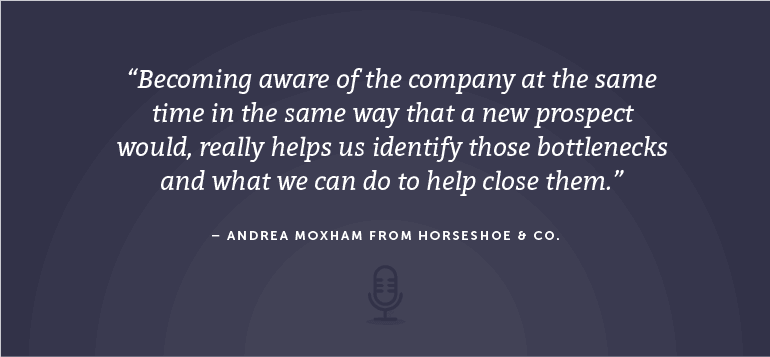 Ben: You've got a client, they're sold on using this particular tool. Their team is onboarded, you've got them up and running and things are going well. At that point, is there anything that you do specifically to help ensure that they can continue to be successful so that they don't want to move off that platform in the future?
Andrea: I think there's a couple of things that we do subconsciously. One because it becomes a tool that really houses all of your initiatives across customer service, sales, marketing, you are going to have people dabbling in there everyday from different departments. So, it's not really something that becomes a tool that you forget about using and you are like, “Oh, should we be using HubSpot?” I think particularly for us and the relationship that we have for clients we work on a monthly basis, so typically the marketing point of contact that we interface with the most, they do a lot of other marketing.
Sometimes it's offline marketing. Sometimes they've got their hand in sales as well, so HubSpot isn't their main focus. Having a weekly or monthly call that we set up from the get-go where all we focus on is HubSpot, I think they really appreciate being able to focus on something so specific. Whereas in the bigger picture of their entire role, they've got a lot going on, so rather than having a really vague marketing meeting where one hour is not nearly enough, it helps us to get really specific and focus on the projects that we were working on.
I would say the third piece is that pretty much every company that we start working with has this wish list of things that they wish HubSpot would do. Projects that they can't seem to figure out how to fix or to integrate with their other tools. We chip away at those, but at the same time we are always looking for opportunities within HubSpot, whether it's a new tool that they've released, or a new feature, or something that they've just completely overlooked using for their companies.
In addition to working through that wishlist that they've got, we're always looking for opportunities to expand with what they're doing with HubSpot. Whether it's making recommendations on migrating from another tool to HubSpot because they are already paying for it, so why not use it? Or an entirely new feature that they may have no idea even exist. I would say that is what keeps them hooked into using more because there's so much you can do in HubSpot. You're never done. It's never like, "Okay. We've setup everything. We're good to go."
I think even though it is a token marketing automation tool, you do still need a human to be setting that up. Like I said, even when you think you are done, there's always more that you can do. There's always different ways that you can be using the existing tool. For example, workflows. There's just so many opportunities, so just being that role in the relationship where identifying those opportunities and ways to really fully leverage HubSpot, I think it's what keeps them engaged with using the platform everyday.
Ben: You've got a client, they're sold on using this particular tool. Their team is onboarded, you've got them up and running and things are going well. At that point, is there anything that you do specifically to help ensure that they can continue to be successful so that they don't want to move off that platform in the future?
Andrea: I think there's a couple of things that we do subconsciously. One because it becomes a tool that really houses all of your initiatives across customer service, sales, marketing, you are going to have people dabbling in there everyday from different departments. So, it's not really something that becomes a tool that you forget about using and you are like, “Oh, should we be using HubSpot?” I think particularly for us and the relationship that we have for clients we work on a monthly basis, so typically the marketing point of contact that we interface with the most, they do a lot of other marketing.
Sometimes it's offline marketing. Sometimes they've got their hand in sales as well, so HubSpot isn't their main focus. Having a weekly or monthly call that we set up from the get-go where all we focus on is HubSpot, I think they really appreciate being able to focus on something so specific. Whereas in the bigger picture of their entire role, they've got a lot going on, so rather than having a really vague marketing meeting where one hour is not nearly enough, it helps us to get really specific and focus on the projects that we were working on.
I would say the third piece is that pretty much every company that we start working with has this wish list of things that they wish HubSpot would do. Projects that they can't seem to figure out how to fix or to integrate with their other tools. We chip away at those, but at the same time we are always looking for opportunities within HubSpot, whether it's a new tool that they've released, or a new feature, or something that they've just completely overlooked using for their companies.
In addition to working through that wishlist that they've got, we're always looking for opportunities to expand with what they're doing with HubSpot. Whether it's making recommendations on migrating from another tool to HubSpot because they are already paying for it, so why not use it? Or an entirely new feature that they may have no idea even exist. I would say that is what keeps them hooked into using more because there's so much you can do in HubSpot. You're never done. It's never like, "Okay. We've setup everything. We're good to go."
I think even though it is a token marketing automation tool, you do still need a human to be setting that up. Like I said, even when you think you are done, there's always more that you can do. There's always different ways that you can be using the existing tool. For example, workflows. There's just so many opportunities, so just being that role in the relationship where identifying those opportunities and ways to really fully leverage HubSpot, I think it's what keeps them engaged with using the platform everyday.
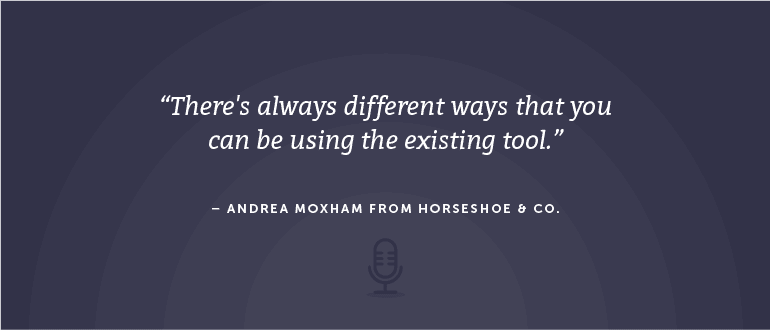 Ben: Got it. For my last question here, for other consultants—certainly I think this could probably apply to more traditional agencies too—in all your years of just onboarding new clients, if you could leave people with one tip that you would want people to know in order to be more successful with their onboarding, what would you leave them with?
Andrea: I guess from which perspective, is it business that are getting on board or that are doing the onboarding themselves?
Ben: That's a really interesting counter-question. I was thinking from your own perspective. As a consultant, or agency owner, or just somebody who is on the consulting or the agency side and you are onboarding the client, but I would also be interested in hearing it both ways because I'm sure that there are things from your perspective that clients could be doing in order to help themselves like help you help them so to speak.
Andrea: I think these are generic recommendations, but they're often the fundamental ones that people overlook. From an agency perspective, I think communication is seriously key. Establishing what effective communication means early on with your client is really helpful. For example, in the beginning when we first started doing HubSpot consulting, we more or less insisted on setting up weekly phone calls with our clients. But as we got to grow our client base, we discovered that that's not the only way to communicate. Sometimes people prefer emails. Sometimes people prefer messaging apps. Just meeting your clients where they want to be met is going to ensure a more successful onboarding process.
Ben: Got it. For my last question here, for other consultants—certainly I think this could probably apply to more traditional agencies too—in all your years of just onboarding new clients, if you could leave people with one tip that you would want people to know in order to be more successful with their onboarding, what would you leave them with?
Andrea: I guess from which perspective, is it business that are getting on board or that are doing the onboarding themselves?
Ben: That's a really interesting counter-question. I was thinking from your own perspective. As a consultant, or agency owner, or just somebody who is on the consulting or the agency side and you are onboarding the client, but I would also be interested in hearing it both ways because I'm sure that there are things from your perspective that clients could be doing in order to help themselves like help you help them so to speak.
Andrea: I think these are generic recommendations, but they're often the fundamental ones that people overlook. From an agency perspective, I think communication is seriously key. Establishing what effective communication means early on with your client is really helpful. For example, in the beginning when we first started doing HubSpot consulting, we more or less insisted on setting up weekly phone calls with our clients. But as we got to grow our client base, we discovered that that's not the only way to communicate. Sometimes people prefer emails. Sometimes people prefer messaging apps. Just meeting your clients where they want to be met is going to ensure a more successful onboarding process.
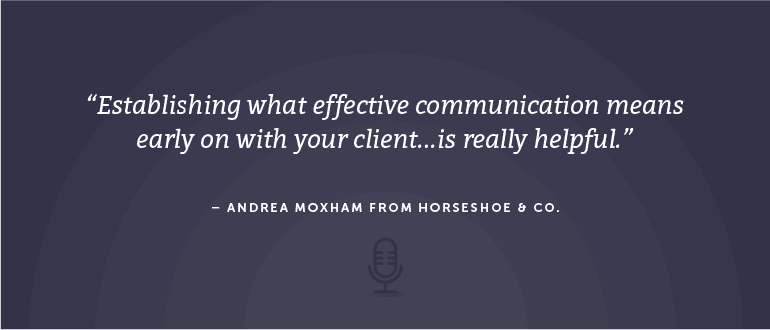 From the client perspective, I think having a solid project management tool where you can see deadlines because it works both ways. Even if you are an agency that's onboarding a new client, it's important for you to meet your deliverables but at the same time projects can quickly come to a halt if the client isn't keeping up. We use teamwork with our clients and we assign them deadlines because it works both ways. You can be clear about expectations early on and treat each other like partners as opposed to agency and client where there's expectations on both sides, I think really helps set us up for success.
Ben: Got it. Very cool. This is a great conversation. I'm sure that our listeners got a lot of helpful advice here just for how they work with their own clients. I really appreciate you taking the time to come on the show.
Andrea: Thanks for having me, Ben. It's really fun.
From the client perspective, I think having a solid project management tool where you can see deadlines because it works both ways. Even if you are an agency that's onboarding a new client, it's important for you to meet your deliverables but at the same time projects can quickly come to a halt if the client isn't keeping up. We use teamwork with our clients and we assign them deadlines because it works both ways. You can be clear about expectations early on and treat each other like partners as opposed to agency and client where there's expectations on both sides, I think really helps set us up for success.
Ben: Got it. Very cool. This is a great conversation. I'm sure that our listeners got a lot of helpful advice here just for how they work with their own clients. I really appreciate you taking the time to come on the show.
Andrea: Thanks for having me, Ben. It's really fun.
